|
Chapter 6
SEEING CORRESPONDENCES
The following morning my wife and children left for a vacation in the mountains. I was going to be alone for ten days. I set
about classifying my notes on the practices and beliefs of both
indigenous and mestizo ayahuasqueros. This work took six days and
revealed a number of constants across cultures.
Throughout Western Amazonia people drink ayahuasca at night,
generally in complete darkness; beforehand, they abstain from sexual
relations and fast, avoiding fats, alcohol, salt, sugar, and all
other condiments.
An experienced person usually leads the
hallucinatory session, directing the visions with songs.1
In many regions, apprentice ayahuasqueros isolate themselves in the
forest for long months and ingest huge quantities of hallucinogens.
Their diet during this period consists mainly of bananas and fish,
both of which are particularly rich in serotonin. It also happens
that the long-term consumption of hallucinogens diminishes the
concentration of this neurotransmitter in the brain.
Most
anthropologists are unaware of the biochemical aspect of this diet,
however, and some go as far as to invent abstract explanations for
what they call "irrational food taboos."2
As I classified my notes, I was looking out for new connections
between shamanism and DNA. I had just received a letter from a
friend who is a scientific journalist and who had read a preliminary
version of my second chapter; he suggested that shamanism was
perhaps "untranslatable into our logic for lack of corresponding
concepts."3 I understood what he meant, and I was trying to see
precisely if DNA, without being exactly equivalent, might be the
concept that would best translate what ayahuasqueros were talking
about.
These shamans insist with disarming consistency on the existence of
animate essences (or spirits, or mothers) which are common to all
life forms.
Among the Yaminahua of the Peruvian Amazon, for
instance, Graham Townsley writes:
"The central image dominating the
whole field of Yaminahua shamanic knowledge is that of yoshi - spirit
or animate essence. In Yaminahua thought all things in the world are
animated and given their particular qualities by yoshi.
Shamanic
knowledge is, above all, knowledge of these entities, which are also
the sources of all the powers that shamanism claims for itself...
it is through the idea of yoshi that the fundamental sameness of the
human and the non-human takes shape."4
When I was in Quirishari, I already knew that the "animist" belief,
according to which all living beings are animated by the same
principle, had been confirmed by the discovery of DNA.
I had learned
in my high school biology classes that the molecule of life was the
same for all species and that the generic information in a rose, a
bacterium, or a human being was coded in a universal language of
four letters. A, G, C, and T, which are four chemical compounds
contained in the DNA double helix.
So the rather obvious relationship between DNA and the animate
essences perceived by ayahuasqueros was not new to me.
The classification of my reading notes did not reveal any further
correspondences.
On my seventh day of solitude, I decided to go to the nearest
university library, because I wanted to follow up a last trail
before getting down to writing: the trail of the life-creating twins
that I had found in Yagua mythology.
As I browsed over the writings of authorities on mythology, I
discovered with surprise that the theme of twin creator beings of
celestial origin was extremely common in South America, and indeed
throughout the world. The story that the Ashaninca tell about
Avíreri and his sister, who created life by transformation, was just
one among hundreds of variants on the theme of the "divine twins."
Another example is the Aztecs' plumed serpent. QuetzalcoatI, who
symbolizes the "sacred energy of life," and his twin brother
Tezcatlipoca, both of whom are children of the cosmic serpent
Coatlicue.5
I was sitting in the main reading room, surrounded by students, and
browsing over Claude Levi-Strauss's latest book, when I Jumped.
I
had just read the following passage:
"In Aztec, the word coatl means
both 'serpent' and 'twin.' The name QuetzalcoatI can thus he
interpreted either as "Plumed serpent' or 'Magnificent twin.'"6
A
twin serpent, of cosmic origin, symbolizing the sacred energy of
life? Among the A/tecs?
It was the middle of the afternoon. I needed to do some thinking. I
left the library and started driving home. On the road back. I could
not stop thinking about what I had just read.
Staring out of the
window, I wondered what all these twin beings in the creation myths
of indigenous people could possibly mean.
When I arrived home. I went for a walk in the woods to clarify my
thoughts. I started by recapitulating from the beginning: I was
trying to keep one eye on DNA and the other on shamanism to discover
the common ground between the two. I reviewed the correspondences
that I had found so far. Then I walked in silence, because I was
stuck.
Ruminating over this mental block I recalled Carlos Perez Shuma's words:
"Look at the FORM."
That morning, at the library, I had looked up DNA in several
encyclopedias and had noted in passing that the shape of the double
helix was most often described as a ladder, or a twisted rope
ladder, or a spiral staircase.
It was during the following split
second, asking myself whether there were any ladders in shamanism,
that the revelation occurred:
"THE LADDERS! The shamans' ladders,
symbols of the profession' according to M6traux, present in shamanic
themes around the world according to Eliade!"
I rushed back to my office and plunged into Mircea Eliade's book
Shamanism: Archaic techniques of ecstasy and discovered that there
were "countless examples" of shamanic ladders on all five
continents, here a "spiral ladder," there a "stairway" or "braided
ropes."
In Australia, Tibet, Nepal, Ancient Egypt, Africa, North and
South America,
"the symbolism of the rope, like that of the ladder,
necessarily implies communication between sky and earth. It is by
means of a rope or a ladder (as, too, by a vine, a bridge, a chain
of arrows, etc.) that the gods descend to earth and men go up to the
sky."
Eliade even cites an example from the Old Testament, where
Jacob dreams of a ladder reaching up to heaven,
"with the angels of
God ascending and descending on it."
According to Eliade, the
shamanic ladder is the earliest version of the idea of an axis of
the world, which connects the different levels of the cosmos, and is
found in numerous creation myths in the form of a tree.
Until then, I had considered Eliade's work with suspicion, but
suddenly I viewed it in a new light.8
I started flipping through his
other writings in my possession and discovered: cosmic serpents.
This time it was Australian Aborigines who considered that the
creation of life was the work of a "cosmic personage related to
universal fecundity, the Rainbow Snake," whose powers were
symbolized by quartz crystals.
It so happens that the Desana of the
Colombian Amazon also associate the cosmic anaconda, creator of
life, with a quartz crystal:

How could it be that Australian Aborigines, separated from the rest
of humanity for 40,000 years, tell the same story about the creation
of life by a cosmic serpent associated with a quartz crystal as is
told by ayahuasca-drinking Amazonians?
The connections that I was beginning to perceive were blowing away
the scope of my investigation.
How could cosmic serpents from
Australia possibly help my analysis of the uses of hallucinogens in
Western Amazonia? Despite this doubt, I could not stop myself and
charged ahead.
I seized the four volumes of Joseph Campbell's comparative work on
world mythology. A German friend had given them to me at the
beginning of my investigation, after I had told him about the book
that I wanted to write. Initially, I had simply gone over the volume
called Primitive mythology. I didn't much like the title, and the
book neglected the Amazon Basin, not to mention hallucinogens.
At
the time, I had placed Campbell's masterpiece at the back of one of
my bookshelves and had not consulted it further. I began paging
through Occidental mythology looking for snakes. To my surprise I
found one in the title of the first chapter.
Turning the first page
I came upon the following figure.
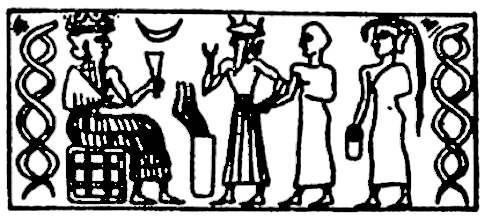
The Serpent Lord Enthroned." From Campbell (1964, p. 11).
This figure is taken from a Mesopotamian seal of c. 2200 B.C. and
shows,
"the deity in human form, enthroned, with his caduceus emblem
behind and a fire altar before."9
The symbol of this
Serpent Lord
was none other than a double helix. The similarity with the
representation of DNA was unmistakable!
I feverishly paged through Campbell's books and found twisted
serpents in most images representing sacred scenes.
Campbell writes
about this omnipresent snake symbolism:
"Throughout the material in
the Primitive, Oriental and Occidental volumes of this work, myths
and rites of the serpent frequently appear, and in a remarkably
consistent symbolic sense. Wherever nature is revered as
self-moving, and so inherently divine, the serpent is revered as
symbolic of its divine life."10
In Campbell's work I discovered a stunning number of creator gods
represented in the form of a cosmic serpent, not only in Amazonia,
Mexico, and Australia, but in Sumer, Egypt, Persia, India, the
Pacific, Crete, Greece, and Scandinavia.
To check these facts, I consulted my French-language Dictionary of
symbols under "serpent."
I read:
"It makes light of the sexes, and
of the opposition of contraries; it is female and male
too, a twin to itself, like so many of the important creator gods
who are always, in their first representation, cosmic serpents....
Thus, the visible snake appears as merely the brief incarnation of a
Great Invisible Serpent, which is causal and timeless, a master of
the vital principle and of all the forces of nature. It is a primary
old god found at the beginning of all cosmogonies, before monotheism
and reason toppled it".11
Campbell dwells on two crucial turning points for the cosmic serpent
in world mythology.
The first occurs,
"in the context of the
patriarchy of the Iron Age Hebrews of the first millennium B.C.,
[where] the mythology adopted from the earlier Neolithic and Bronze
Age civilizations... became inverted, to render an argument just
the opposite to that of its origin."
In the Judeo-Christian creation
story told in the first book of the Bible, one finds elements which
are common to so many of the worlds creation myths: the serpent, the
tree, and the twin beings; but for the first time, the serpent,
"who
had been revered in the Levant for at least seven thousand years
before the composition of the Book of Genesis," plays the part of
the villain.
Yahweh, who replaces it in the role of die creator,
ends up defeating,
"the serpent of the cosmic sea. Leviathan."12
For Campbell, the second turning point occurs in Greek mythology,
where Zeus was initially represented as a serpent; but around 500
B.C., the myths are changed, and Zeus becomes a serpent-killer.
He
secures the reign of the patriarchal gods of Mount Olympus by
defeating Typhon, the enormous serpent-monster who is the child of
the earth goddess Gaia and die incarnation of the forces of nature.
Typhon,
"was so large that his head often knocked against the stars
and his arms could extend from sunrise to sunset."
In order to
defeat Typhon, Zeus can count only on the help of Athene, "Reason,"
because all the other Olympians have fled in terror to Egypt.13
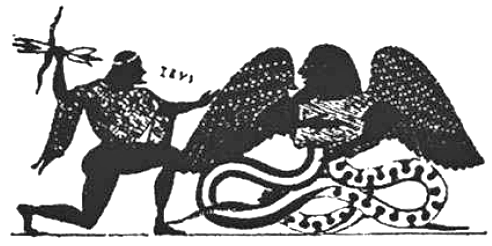
"Zeus against Typhon." From Campbell (1964, p. 239).
At this point, I wrote in my notes:
"These patriarchal and
exclusively masculine gods are incomplete as far as nature is
concerned. DNA, like the cosmic serpent, is neither masculine nor
feminine, even though its creatures are either one or the other, or
both. Gaia, the Greek earth goddess, is as incomplete as Zeus. Like
him, she is the result of the rational gaze, which separates before
thinking, and is incapable of grasping the androgynous and double
nature of the vital principle."
It was past 8 p.m. and I had not eaten. My head was spinning in the
face of the enormity of what I thought I was discovering. I decided
to pause. I took a beer out of the refrigerator and put on some
violin music. Then I started pacing up and down my office.
What
could all this possibly mean?
I turned on the tape recorder and tried answering my own question:
"One, Western culture has cut itself off from the serpent/life principle, in other words DNA, since it adopted an
exclusively rational point of view. Two, the peoples who practice
what we call 'shamanism' communicate with DNA. Three, paradoxically,
the part of humanity that cut itself off from the serpent managed to
discover its material existence in a laboratory some three thousand
years later.
"People use different techniques in different places to gain access
to knowledge of the vital principle. In their visions shamans manage
to take their consciousness down to the molecular level. This is
precisely what Reichel-Dolmatoff describes, in his running
commentary into the tape recorder of his own ayahuasca-induced
visions ('like microphotographs of plants; like those microscopic
stained sections; sometimes like from a pathology textbook').14
'This is how they learn to combine brain hormones with monoamine
oxidase inhibitors, or how they discover forty different sources of
muscle paralyzers whereas science has only been able to imitate
their molecules. When they say the recipe for curare was given to
them by the beings who created life, they are talking literally-
When they say their knowledge comes from beings they see in their
hallucinations, their words mean exactly what they say.
"According to the shamans of the entire world, one establishes
communication with spirits via music. For the ayahuasqueros, it is
almost inconceivable to enter the world of spirits and remain
silent. Angelika Gebhart-Sayer discusses the 'visual music'
projected by the spirits in front of the shaman's eyes; It is made
up of three-dimensional images that coalesce into sound and that the
shaman imitates by emitting corresponding melodies.15
I should check
whether DNA emits sound or not.
"Another way of testing this idea would be to drink ayahuasca
and observe the microscopic images".
As I said this, it dawned on me that I could approach this
experience by looking at the book of paintings by
Pablo Amaringo, a
retired Peruvian ayahuasquero with a photographic memory.
These paintings are published in a book called Ayahuasca visions: The religious iconography of a Peruvian shaman, by Luis Eduardo Luna
and Pablo Amaringo.
In this book, Luna die anthropologist provides a
mine of information on Amazonian shamanism, giving the context for
fifty paintings of great beauty by Amaringo. The first time I saw
these paintings, I was struck by their resemblance to my own
ayahuasca-induced visions.
According to Amaringo:
"I only paint what
I have seen, what I have experienced. I don't copy or take ideas for
my paintings from any book." Luna says: "I have shown Pablo's
paintings to several vegetalistas, and they have reacted with
immediate interest and wonder - some have commented on how similar
their own visions were to those depicted by Pablo, and some even
recognize elements in them."16
On opening the book, I was stupefied to find all kinds of zigzag
staircases, entwined vines, twisted snakes, and, above all, usually
hidden in the margins, double helixes, like this one:

Several weeks later, I showed these paintings to a friend with a
good understanding of molecular biology.
He reacted in the same way
as the vegetalistas to whom Luna had shown them:
"Look,
there's collagen.. .. And there, the axon's embryonic network with
its neurites... Those are triple helixes And that's DNA from
afar, looking like a telephone cord This looks like chromosomes
at a specific phase.... There's the spread-out form of DNA, and
right next to it are DNA spools in their nucleosome structure."
Even without these explanations, I was in shock.
I quickly went over
the index of Ayahuasca visions, but found no mention of either
DNA, chromosomes, or double helixes.
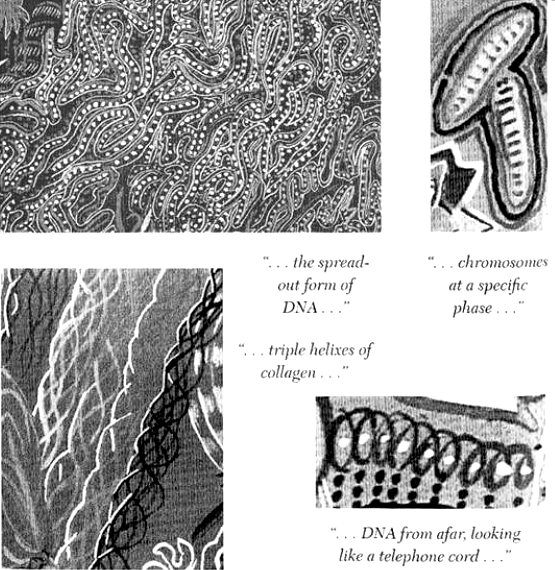
Was it possible that no one had noticed the molecular aspect of the
images?
Well, yes, because I myself had often admired them and
showed them to people to explain what the hallucinatory sphere
looked like, and I had not noticed them either.
My gaze had been as
focalized as usual. I had not been able to see simultaneously
molecular biology and shamanism, which our rational mind
separates - but which could well overlap and correspond.
I was staggered. It seemed that no one had noticed the possible
links between the "myths" of "primitive peoples" and molecular
biology.
No one had seen that the double helix had symbolized the
life principle for thousands of years around the world. On the
contrary, everything was upside down. It was said that
hallucinations could in no way constitute a source of knowledge,
that Indians had found their useful molecules by chance
experimentation, and that their "myths" were precisely myths,
bearing no relationship to the real knowledge discovered in
laboratories.
At this point I remembered Michael Harner's story. Had he not said
that this information was reserved for the dead and the dying?
Suddenly, I was overcome with fear and felt the urge to share these
ideas with someone else. I picked up the phone and called an old
friend, who is also a writer. I quickly took him through the
correspondences I had found during the day: the twins, the cosmic
serpents, Eliades ladders, Camplwlls double helixes, as well as
Amaringos.
Then I added:
"There is a last correlation that is
slightly less clear than the others. The spirits one sees in
hallucinations are three-dimensional, sound-emitting images, and
they speak a language made of three-dimensional, sound-emitting
images. In other words, they are made of their own language, like
DNA."
There was a long silence on the other end of the line.
Then my friend said,
"Yes, and like DNA they replicate themselves to
relay their information."
"Wait," I said, "I'm going to jot that
down."
"Precisely," he said, "instead of talking to me, yon should
be writing this down."18
I followed his advice, and it was in writing my notes on the
relationship between the hallucinatory spirits made of language and
DNA that I remembered the first verse of the first chapter of the
Gospel according to John: "In the beginning was the logos" - the word,
the verb, the language.
That night I had a hard time falling asleep.
The next day I had to attend a professional meeting that bore no
relationship to my research. I took advantage of the train ride to
put things into perspective. I was feeling strange. On the one hand,
entire blocks of intuition were pushing me to believe that the
connection between DNA and shamanism was real. On the other hand, I
was aware that this vision contradicted certain academic ideas, and
that the links I had found so far were insufficient to trouble a
strictly rational point of view.
Nonetheless, gazing out the train window at a random sample of the
the Western world, I could not avoid noticing a land of separation
between human beings and all other species. We cut ourselves off by
living in cement blocks, moving around in glass-and-metal bubbles,
and spending a good part of our time watching other human beings on
television.
Outside, the pale light of an April sun was shining down
on a suburb. I opened a newspaper and all I could find were pictures
of human beings and articles about their activities. There was not a
single article about another species.
Sitting on the train, I measured the paradox confronting me. I was a
resolutely Western individual, and yet I was starting to believe in
ideas that were not receivable from a rational point of view. This
meant that I was going to have to find out more about DNA. Up to
this point, I had only found biological correspondences in
shamanism. It remained to be seen whether the contrary was also
true, and whether there were shamanic correspondences in biology.
More precisely, I needed to see whether shamanic notions about
spirits corresponded to scientific notions about DNA. Basically I
had only covered, at best, half the distance.
Even though my bookshelves were well stocked in anthropology and
ecology, I owned no books about DNA or molecular biology; but I knew
a colleague trained in both chemistry and literature who was going
to be able to help me on that count.
After the meeting, toward the end of the afternoon, I went over to
my colleagues house. He had generously allowed me to look through
his books in his absence.
I entered his office, a big room with an entire wall occupied by
bookshelves, turned on the light, and started browsing. The biology
section contained, among others. The double helix by James Watson,
the co-discoverer with
Francis Crick of the structure of DNA.
I
flipped through this book, looking at the pictures with interest,
and put it aside.
A little further along on the same shelf, I came upon a book by
Francis Crick entitled Life itself: Its origin and nature. I pulled
it out and looked at its cover - and could not believe my eyes. It
showed an image of the earth, seen from space, with a rather
indistinct object coming from the cosmos and landing on it.
Francis Crick, the Nobel Prize-winning co-discoverer of the
structure of DNA, was suggesting that the molecule of life was of
extraterrestrial origin - in the same way that the "animist"
peoples claimed that the vital principle was a serpent from the
cosmos.
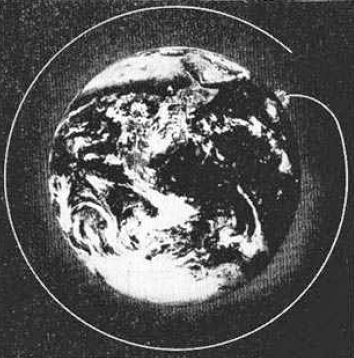
Cover of Crick (1981)
I had never heard of Crick's hypothesis,
called "directed panspermia," but I knew that I had just found a new
correspondence between science and the complex formed by shamanism
and mythology.
I sat down in the armchair and plunged into Life itself: Its origin
and nature.
Crick, writing In the early 1980s, criticizes the usual scientific
theory on the origin of life, according to which a cell first
appeared in the primitive soup through the random collisions of
disorganized molecules.
For Crick, this theory presents a major
drawback: It is based on ideas conceived in the nineteenth century,
long before molecular biology revealed that the basic mechanisms of life are identical for all species and are extremely
complex - and when one calculates the probability of chance producing
such complexity, one ends up with inconceivably small numbers.
The DNA molecule, which excels at stocking and duplicating
information, is incapable of building itself on its own. Proteins do
this, but they are incapable of reproducing themselves without the
information contained in the DNA. Life, therefore, is a seemingly
inescapable synthesis of these two molecular systems. Moving beyond
the famous question of the chicken and the egg.
Crick calculates the
probability of the chance emergence of one single protein (which
could then go on to build the first DNA molecule). In all living
species, proteins are made up of exactly the same 20 amino acids,
which are small molecules.
The average protein is a long chain made
up of approximately 200 amino acids, chosen from those 20, and
strung together in the right order. According to the laws of
combinatorial, there is I chance in 20 multiplied by itself 200 times
for a single specific protein to emerge fortuitously. This figure,
which can be written 20200, and which is roughly equivalent to
10260, is enormously greater than the number of atoms in the
observable universe (estimated at 1080).
These numbers are inconceivable for a human mind.
It is not possible
to imagine all the atoms of the observable universe and even less a
figure that is billions of billions of billions of billions of
billions (etc.) times greater. However, since the beginning of life
on earth, the number of amino acid chains that could have been
synthesized by chance can only represent a minute fraction of all
the possibilities.
According to Crick:
"The great majority of
sequences can never have been synthesized at all, at any time. These
calculations take account only of the amino acid sequence. They do
not allow for the fact that many sequences would probably not fold up satisfactorily into a stable, compact shape. What
fraction of all possible sequences would do this is not known,
though it is surmised to be fairly small."
Crick concludes that the
organized complexity found at the cellular level "cannot have arisen
by pure chance."
The earth has existed for approximately 4.5 billion years. In the
beginning it was merely a radioactive aggregate with a surface
temperature reaching the melting point of metal. Not really a
hospitable place for life.
Yet there are fossils of single-celled
beings that are approximately 3.5 billion years old. The existence
of a single cell necessarily implies the presence of DNA, with its
4-letter "alphabet" (A, G, C, T), and of proteins, with their
20-letter "alphabet" (the 20 amino acids), as well as a "translation
mechanism" between the two - given that the instructions for the
construction of proteins are coded in die language of DNA.
Crick
writes:
"It is quite remarkable that such a mechanism exists at all
and even more remarkable that every living cell, whether animal,
plant or microbial, contains a version of it."19
Crick compares a protein to a paragraph made up of 200 letters lined
up in the correct order.
If the chances are infinitesimal for one
paragraph to emerge in a billion years from a terrestrial soup, the
probability of the fortuitous appearance, during the same period, of
two alphabets and one translation mechanism is even smaller.
When I looked up from Crick's book, it was dark outside. I was
feeling both astonished and elated. Like a myopic detective bent
over a magnifying glass while following a trail, I had fallen into a
bottomless hole. For months I had been trying to untangle the enigma
of the hallucinatory knowledge of Western Amazonia's indigenous
people, stubbornly searching for the hidden passage in
the apparent dead end.
I had only detected the DNA trail two weeks
previously in Harner's book. Since then I had mainly developed the
hypothesis along intuitive lines.
My goal was certainly not to build
a new theory on the origin of life; but there I was - a poor
anthropologist knowing barely how to swim, floating in a cosmic
ocean filled with microscopic and bilingual serpents. I could see
now that there might be links between science and shamanic,
spiritual and mythological traditions, that seemed to have gone
unnoticed, doubtless because of the fragmentation of Western
knowledge.
With his book, Francis Crick provided a good example of this
fragmentation. His mathematics were impeccable, and his reasoning
crystalline; Crick was surely among twentieth-century rationality's
finest. But he had not noticed that he was not the first to propose
the idea of a snake-shaped vital principle of cosmic origin.
All the
peoples in the world who talk of a cosmic serpent have been saving
as much for millennia. He had not seen it because the rational gaze
is forever focalized and can examine only one thing at a time. It
separates things to understand them, including the truly
complementary. It is the gaze of the specialist, who sees the fine
grain of a necessarily restricted field of vision.
When Crick set
about considering cosmogony from the serious perspective of
molecular biology, he had long since put out of his analytical mind
the myths of archaic peoples.
From my new point of view. Crick's scenario of "directed
panspermia," in which a spaceship transports DNA in the form of
frozen bacteria across the immensities of the cosmos, seemed less
likely than the idea of an omniscient and terrifying cosmic serpent
of unimaginable power.
After all, life as described by Crick was
based on a miniature language that had not changed a letter in four
billion years, while multiplying itself in an extreme diversity
of species. The petals of a rose, Francis Cricks brain, and the coat
of a virus are all built out of proteins made up of exactly the same
20 amino acids.
A phenomenon capable of such creativity was surely
not going to travel in a spaceship resembling those propelled
containers imagined by human beings in the twentieth century.
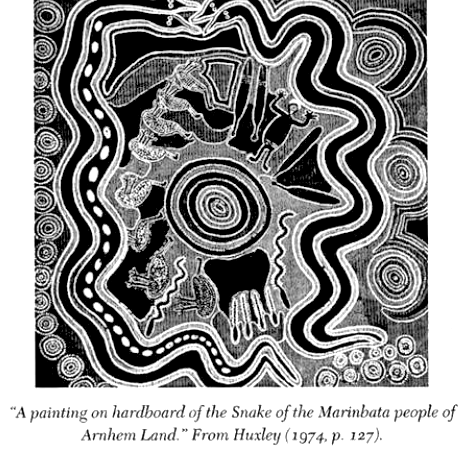
This meant that the gaze of the Western specialist was too narrow to
see the two pieces that fit together to resolve the puzzle.
The
distance between molecular biology and shamanism/mythology was an
optical illusion produced by the rational gaze that separates things
ahead of time, and as objectivism fails to objectify its
objectifying relationship, it also finds it difficult to consider
its re-suppositions.
The puzzle to solve was: Who are we and where do we come from?
Lost in these thoughts, I started wondering about the cosmic serpent
and its representation throughout the world. I walked over to the
philosophy and religion sections in my colleague's library. Fairly
rapidly I came across a book by Francis Huxley entitled The way of
the sacred, filled with pictures of sacred images from around the
world.
I found a good number of images containing serpents or
dragons, and in particular two representations of the Rainbow Snake
drawn by Australian Aborigines.
The first showed a pair of snakes
zigzagging in the margins.
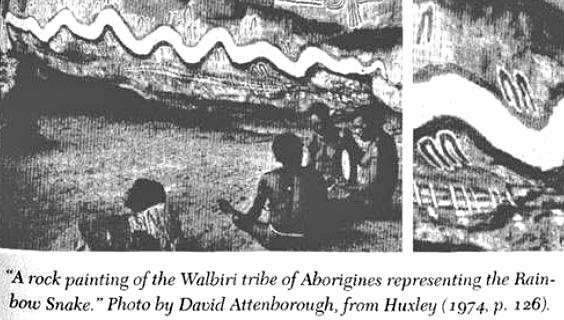
The second was a rock painting of the Rainbow Snake.
I looked at it
more closely and saw two things: All around the serpent there were
sorts of chromosomes, in their upside-down "U" shape, and underneath
it there was a kind of ladder.
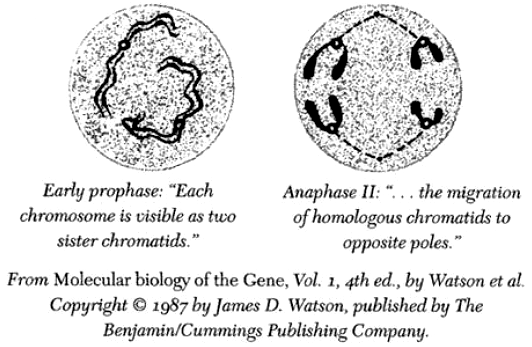
I rubbed my eyes, telling myself that I had to be imagining
connections, but I could not get the ladder or the chromosomes to
look like anything else.
Several weeks later I learned that U-shaped chromosomes were in
"anaphase," one of the stages of cellular duplication, which is the
central mechanism of the reproduction of life; and the first image
of the zigzag snakes looks strikingly like chromosomes in the "early
prophase," at the beginning of the same process.
However, I did not need this detail to feel certain now that the
peoples who practice shamanism know about the hidden unity of
nature, which molecular biology has confirmed, precisely because
they have access to the reality of molecular biology.
It was at this point, in front of the picture of chromosomes painted
by
Australian Aborigines, that I sank into a fever of mind and soul
that was to last for weeks, during which I floundered in dissonant
mixes of myths and molecules.
Back to Contents
|








